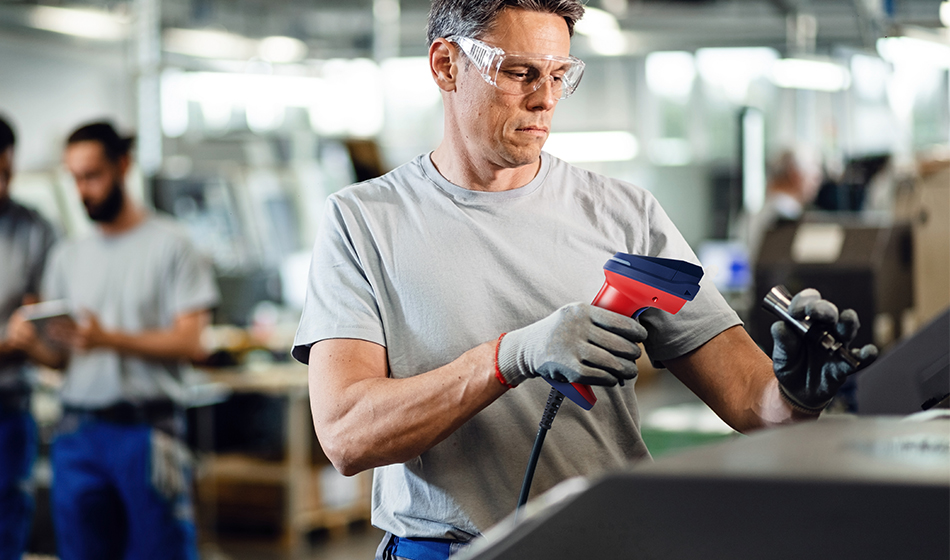
Logistics workers want tools they can trust to help their jobs. The world market for advanced barcode readers was $1,042 million in 2025. North America and Western Europe use them a lot. Asia-Pacific is starting to use them more and more.
Aspect | Details |
|---|---|
Market Size (2025) | $1042 million |
Dominant Reader Type | Handheld scanners |
Technology Trends | 2D imagers, wireless, rugged devices |
Advanced barcode readers help track items and stop mistakes.
These devices can cut fulfillment mistakes by half.
88% of warehouses say they work better with them.
The best barcode reader helps you see things right away and work faster.
Key Takeaways
Advanced barcode readers help logistics by lowering errors and making work faster. – Strong, wireless scanners with long battery life work well in hard warehouse places. – 2D imagers read both 1D and 2D codes quickly, even if barcodes are broken. – Wearable and hands-free scanners let workers stay comfy and do their jobs faster. – Picking the right scanner means matching its features to your warehouse needs and trying out devices in real work.
Best Barcode Scanners List 2025
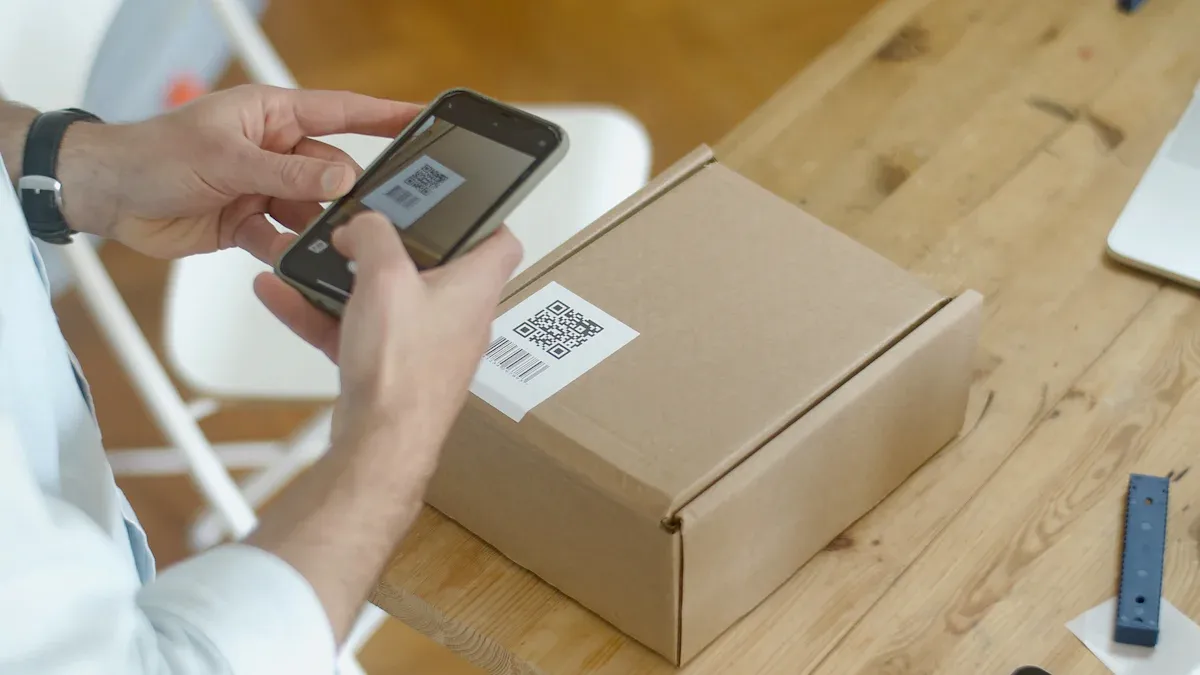
Ranked Overview
To pick the best barcode reader in 2025, you need to think carefully. People who work in logistics want devices that can handle rough places. They also need them to work fast. The top 10 models are strong, quick, and have smart features. These devices are:
Datalogic Gryphon GFS4400
EFFON TH22 Barcode Readers
Honeywell Xenon Performance 1952g
Tera D5100
Zebra DS3600 Series
MUNBYN 088P
ProGlove Wearable
Honeywell Granit 1910i
Zebra Technologies Handheld
CipherLAB 2560
The ranking looks at many things:
Can it survive drops, dust, or hot and cold?
Does it scan fast to keep work moving?
Is it wireless so you can move around?
Can it scan things that are moving?
Does the battery last a whole shift?
Can it read damaged barcodes with AI?
Is it easy and light to hold?
Does it work with 1D, 2D, and QR codes?
Does it save power for longer use?
Can it track inventory right away?
These points make sure each device works well in warehouses, shipping, and factories.
Comparison Table
Model | Ruggedness | Scanning Range | Battery Life | Wireless | Compatibility |
|---|---|---|---|---|---|
Datalogic Gryphon GFS4400 | High | Medium | 12 hrs | Yes | 1D/2D/QR |
Honeywell Granit XP 1991iSR | Extreme | Long | 16 hrs | Yes | 1D/2D |
Honeywell Xenon 1952g | High | Medium | 14 hrs | Yes | 1D/2D/QR |
Tera D5100 | Medium | Short | 10 hrs | Yes | 1D/2D |
Zebra DS3600 Series | Extreme | Long | 18 hrs | Yes | 1D/2D/QR |
MUNBYN 088P | Medium | Medium | 12 hrs | Yes | 1D/2D |
ProGlove Wearable | High | Short | 8 hrs | Yes | 1D/2D |
Honeywell Granit 1910i | Extreme | Long | 15 hrs | No | 1D/2D |
Zebra Technologies Handheld | High | Medium | 13 hrs | Yes | 1D/2D/QR |
CipherLAB 2560 | Medium | Medium | 11 hrs | Yes | 1D/2D |
This table lets teams see which barcode reader fits their job best. Each one is tough, scans well, and can be used without wires. The best choice depends on what your team needs and where you work.
Selection Criteria
When picking a barcode reader for logistics in 2025, you need to think about a few big things. Every warehouse or shipping place is different. These points help teams choose the best barcode reader for their work.
Durability
Logistics workers sometimes drop their devices. They also use them where it is dusty or wet. The best barcode readers are made with strong cases and shock pads. Many can survive falling from high places. Devices with high IP ratings, like IP65, IP67, or IP68, keep out dust and water.
IP65 keeps out dust and can handle water sprays. It works well in dusty or rainy places.
IP67 blocks dust and can stay under water for 30 minutes.
IP68 keeps working after being in water for over an hour.
These things help scanners last longer and stop them from breaking down.
Scanning Performance
How fast and how far a scanner works is important in busy places. Laser scanners can read barcodes quickly from far away. This helps when items are on high shelves. CCD scanners are good for close-up scans and cost less money. Imaging scanners can read 1D and 2D barcodes, even if they are damaged. Some mobile scanners use AI to scan faster and better. This can save up to 30% of the time.
Speed & Range | Use Cases | |
|---|---|---|
Laser | Fast and works from far away | Warehouses, inventory |
CCD | Good for short range and reliable | Product checks, documents |
2D Imager | Reads 1D and 2D, medium speed and range | Payments, complex barcodes |
Mobile Scanner | Easy to carry, saves up to 30% time | Field sales, warehousing |
Smartphone Scanner | Uses AI, as fast as hardware | Events, inventory |
Wireless & Connectivity
Today, logistics teams need barcode readers without wires. Bluetooth and Wi-Fi are found in the best models. These let workers move around and connect to systems easily. Brands like Honeywell and Zebra have both Bluetooth and Wi-Fi. USB is still there but not used as much. Wireless readers help teams work faster and keep data moving.
Compatibility
Barcode readers must work with warehouse management systems. Devices use Wi-Fi and mobile computers to send data right away. This helps keep inventory right and makes picking orders faster.
Barcode readers and WMS need to use the same tech.
Good Wi-Fi and mobile devices help track things in real time.
Connecting the systems saves money and stops mistakes.
The system should be able to grow and handle more products.
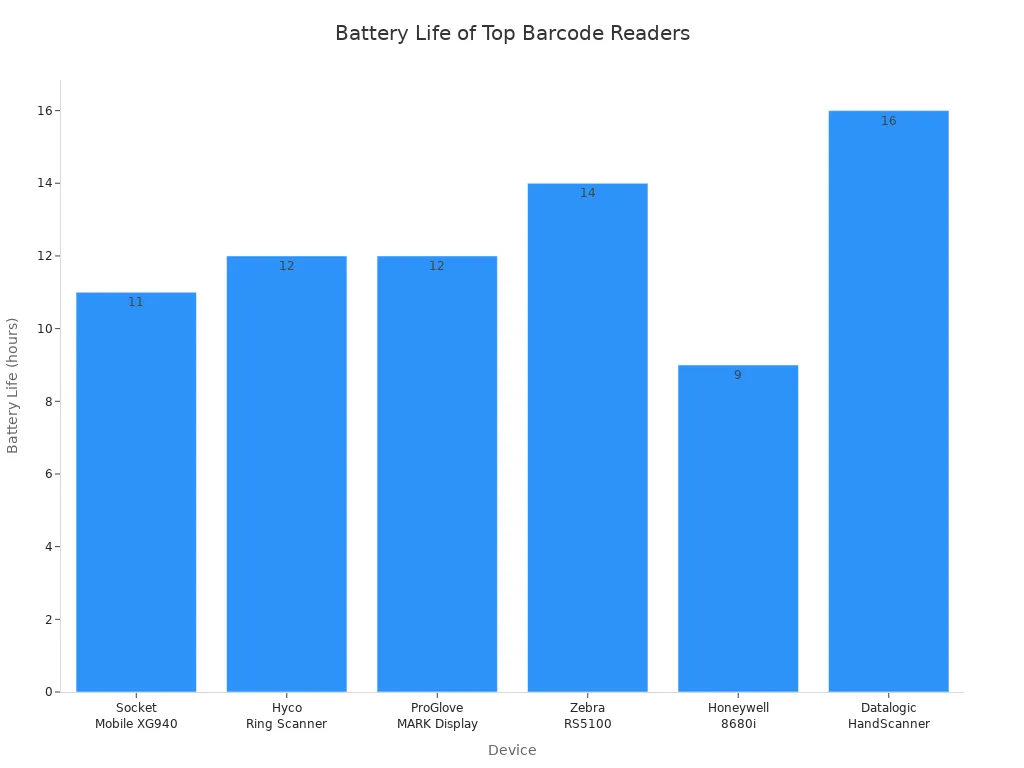
Tip: Pick barcode readers that can scan both 1D and 2D codes and work in tough places. This helps your device last longer and stay useful as your business gets bigger.
Product Reviews
Zebra-DS3678-Bluetooth-Scanner
The Zebra DS3678 Bluetooth Scanner is tough and smart. It works well in places like warehouses and cold storage. It can scan 1D and 2D barcodes, even if they are hard to read. Workers use Bluetooth to move around without wires.
Feature | Details |
|---|---|
Durability | |
Scan Range | |
Battery | PowerPrecision+ with health monitoring |
Connectivity | Bluetooth 4.0, Wi-Fi Friendly Mode |
Extra Features | Multi-code capture, OCR, vibration feedback |
Pros:
Works in tough places and cold or hot weather
Can scan many barcodes at the same time
Battery lasts a whole work shift
Easy to control from far away
Cons:
Heavier than other scanners
Costs more money
Ideal Use Cases:
This scanner is good for big warehouses and busy docks. Teams who need fast and correct scans will like it.
The Zebra DS3678 helps teams do their jobs faster and make fewer mistakes. It is a great pick for hard jobs.
EFFON PTH5 Barcode Reader
The EFFON PTH5 is a reliable, durable, and best high-performance scanner,efficient wireless barcode scanner—perfect for high-volume, varied environments requiring long-range, fast scanning with hygiene considerations. From hefty warehouse use to sanitary healthcare settings, its feature set positions it as a versatile tool for modern scanning demands.
Main Features:
Wireless Connectivity & Range
Supports Bluetooth 5.0 and 2.4 GHz wireless modes, offering a remarkable effective range of up to 250 meters in open spaces—ideal for expansive areas like warehouses and large storesVersatile Scanning Capabilities
Seamlessly reads 1D, 2D, postal barcodes, and even OCR (optical character recognition) data with omnidirectional, high-speed scanning—reliable even on smartphone screens or low-quality labelsRobust & Sanitation-Friendly Design
Encased with an IP65-rated housing, it resists dust and splashes and is disinfectant-ready, making it suitable for healthcare, food-handling, or public-facing environmentsLong Battery Life
Packs a 2500 mAh battery, offering up to 12 hours of operation. Battery is replaceable, so shifts stay uninterrupted, and recharges in about 5–6 hours
Pros:
Works well in busy warehouses
Simple to set up and use
Connects with many warehouse systems
Cons:
Not as tough as some other scanners
Does not scan as far as some models
Ideal Use Cases:
This scanner is good for picking orders and checking inventory in big warehouses.
CipherLAB-2560
The CipherLAB 2560 is a high-quality barcode scanners easy to use and works well. It uses a laser to scan 1D and 2D barcodes from up to 30 feet away. The scanner has an IP54 rating, so it keeps out dust and water but is not the toughest.
Big battery lets you scan for 24 hours
Light and easy to hold for long times
Bluetooth lets you use it without wires
Pros:
Battery lasts a long time
Scans far enough for most jobs
Feels good in your hand
Cons:
Not strong enough for very rough places
Bluetooth does not reach as far as others
Ideal Use Cases:
Best for warehouses that need good range and comfort, but not super toughness.
Datalogic-QBT2500
The Datalogic QBT2500 is good for scanning in logistics. It reads 1D and 2D barcodes and connects with Bluetooth. The scanner is strong and fits well in your hand.
Main Features:
Scans fast
Bluetooth for wireless use
Can handle drops
Battery lasts a long time
Pros:
Simple to use and set up
Good for scanning lots of items
Works with warehouse systems
Cons:
Not as tough as the strongest scanners
Does not scan as far as some others
Ideal Use Cases:
Good for small to medium warehouses and shipping areas.
EFFON TH22
The EFFON TH22 is a wireless scanner for big warehouses. It can scan from far away, up to 250 meters. The battery lets you scan 50,000 times before charging. The scanner is tough and can handle drops and water.
Pros | Cons |
|---|---|
Costs more at first | |
Scans from far away | Needs to be charged often |
Scans many times per charge | Signal can get blocked |
Tough and strong | Bigger than wired scanners |
Updates data right away |
Ideal Use Cases:
This scanner is best for big warehouses where workers move a lot and scan from far away.
The EFFON TH22 helps teams cover more space and waste less time. It is a good choice for busy places.
EFFON GS02 Glove Barcode Scanner
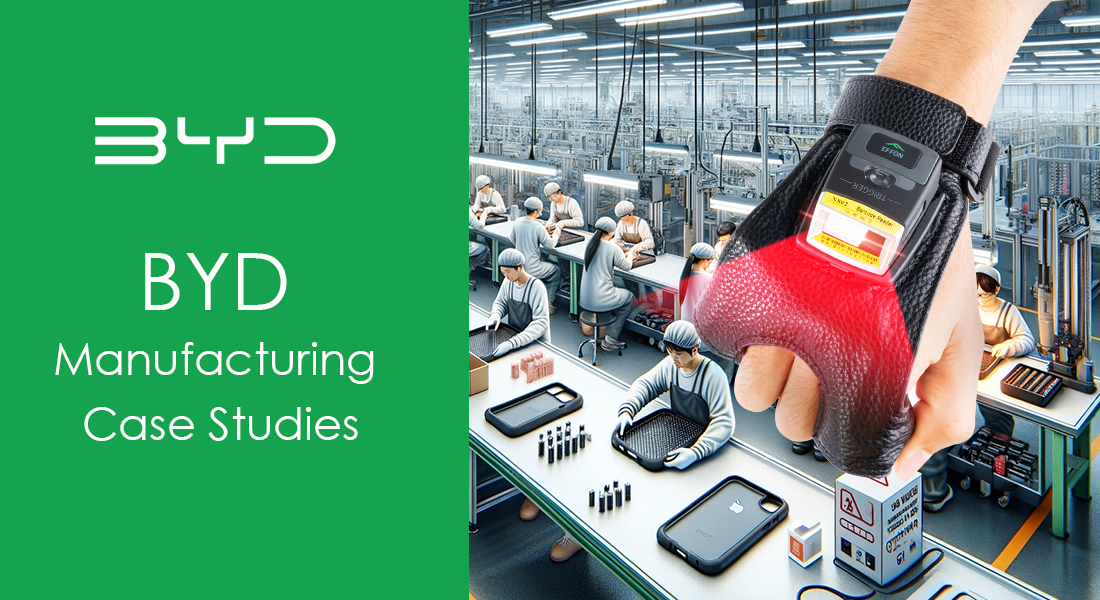
The EFFON GS02 Glove Barcode Scanner lets workers scan without using their hands. They wear it like a glove and can pick up things while scanning. It uses a Zebra scan engine to read 1D and 2D barcodes fast.
Hands-free use helps workers move and not get tired
Can save over 6,000 barcodes when offline
Works for 8–10 hours on one charge
Best wearable scanner for 3PL logistics
Pros:
Makes picking and packing faster
Light and easy to wear
Pairs quickly with NFC
Cons:
Battery does not last for very long shifts
May need to fit different hand sizes
Ideal Use Cases:
Great for fast picking and packing when workers need both hands.
Proglove Wearable Scanner
The ProGlove Wearable Scanner makes work faster and more comfortable. Workers wear it on the back of their hand, so their palm is free. This helps stop sore muscles and makes scanning quicker.
Light and fits all hands
Updates can make battery and scans better
Strength Aspect | Summary |
|---|---|
Ergonomics | Stops sore muscles, helps wrists move better |
Productivity | Makes work up to 20% faster, cuts mistakes by a third |
Battery | Can scan up to 7,000 times per charge |
Analytics | Connects to ProGlove INSIGHT for tracking and managing devices |
Pros:
Makes work faster and more correct
Feels good for long shifts
Easy to update and manage
Cons:
Not as tough as some handheld scanners
May not work for every warehouse job
Ideal Use Cases:
Best for picking, packing, and sorting in busy places.
Newland-HR32-BT
The Newland HR32 BT is a wireless scanner for logistics. It reads 1D and 2D barcodes and uses Bluetooth. The scanner is strong and the battery lasts a long time.
Main Features:
Scans fast and correct
Bluetooth for wireless use
Can handle drops
Battery lasts long
Pros:
Simple to use
Good for scanning lots of items
Works with many warehouse systems
Cons:
Not as tough as some other scanners
Does not scan as far as some models
Ideal Use Cases:
Good for small to medium warehouses and backrooms.
Zebra RS6100 Wearable Scanner
The Zebra RS6100 Wearable Scanner is small and light. It is less than half the size and weight of old models. Workers can wear it in five ways, like on the finger or wrist.
Works without cords using Bluetooth or with a cord
Tough enough for freezers and docks
Batteries can be swapped quickly for nonstop use
NFC pairing and lights give feedback
Pros:
Fits many jobs and people
Works in hard places
Scans hard-to-read or far barcodes
Quick battery changes stop downtime
Cons:
New users may need training
Costs more than simple scanners
Ideal Use Cases:
Great for managing warehouses, picking, loading, and inventory in tough places.
Datalogic Hand Scanner
The Datalogic Hand Scanner is the smallest wearable scanner for logistics. Workers wear it on the back of the hand, so both hands are free. It is light and comfy for long work times.
Feature/Benefit | Description |
|---|---|
Hands-Free Operation | Worn on hand, lets you move easily |
Battery Life | |
Fast Recharge | Charges fully in 2 hours |
Ruggedness | Handles drops and shaking |
Feedback | Gives sound, vibration, and light signals |
Connectivity | Pairs with phones or vehicle computers using Bluetooth |
Productivity | Makes 33% fewer mistakes, scans faster |
Ergonomics | Stops strain, feels like a glove |
Pros:
Makes picking faster and more correct
Feels good for all-day use
Charges quickly
Cons:
Not as tough as some other scanners
May not fit every hand
Ideal Use Cases:
Good for mobile work, picking, and inventory when workers need both hands.
Wearable and hands-free scanners like the Datalogic Hand Scanner and ProGlove help teams work faster and make fewer mistakes. These devices give the best barcode reader experience for today’s warehouses.
How to Choose the Best Barcode Reader
Picking the right barcode reader means matching its features to your needs. Logistics managers should think about a few important things before buying.
Logistics Environment
Warehouse conditions matter a lot when picking a scanner. Dust, water, and changes in temperature can break normal scanners. Managers should look for scanners that are tough and can handle drops. Waterproofing is also important. Devices with high IP ratings, like IP65 or IP68, protect better. The table below shows what to think about:
Factor | Considerations |
|---|---|
Ruggedness | Drop resistance (4ft to 10ft+), IP ratings (IP54 to IP68) for dust and water protection |
Scan Range | Standard (few inches to 30″), Mid-range (up to 15 ft), Long-range (50-70 ft for high racks) |
Form Factor | Handheld, pistol-grip, wearable |
Operating System | Android preferred for future-proofing and integration |
Price vs Features | Balance cost with needed features |
Connectivity | Bluetooth, Wi-Fi, USB options |
Tip: Managers should look at how the warehouse is set up. They should also check where barcodes are placed. Long-range scanners help when items are high up.
Barcode Types
The kind of barcode you use changes which scanner is best. Most teams use both 1D and 2D barcodes. 1D barcodes need laser scanners. These cost less but only work at certain angles. 2D barcodes need imaging scanners. Imaging scanners read codes from any direction. They also work on damaged or tiny barcodes. 2D imagers can scan both 1D and 2D codes, so they are more useful.
1D scanners: Good for simple jobs that do not cost much.
2D imagers: Better for fast, correct scans and hard codes.
Integration Needs
Barcode readers must work with warehouse systems and other software. If they do not fit, work can slow down. Problems can include not working with other systems, wrong data, or slow updates. The table below shows common problems and ways to fix them:
Integration Challenge | Description | Common Solutions |
|---|---|---|
Difficulty integrating barcode readers with ERP, POS, and inventory systems | Use APIs and middleware to translate barcode data into compatible formats | |
Data Accuracy and Integrity | Errors from damaged labels or environmental factors | Use high-quality labels, data validation, and maintain equipment |
Scalability and Volume Handling | Managing more transactions as business grows | Adopt scalable, cloud-based barcode systems |
Real-time Synchronization Delays | Delays in updating inventory data across systems | Use real-time synchronization with APIs or webhooks |
Mobile Device Integration | Ensuring scanning works on smartphones and tablets | Choose mobile-friendly scanning apps and test across devices |
Note: Managers should talk to staff and IT teams. This helps make sure the barcode reader works with current systems.
Budget
Price is important when picking a barcode reader. Simple 1D scanners cost between $50 and $200. More advanced 2D scanners cost $150 to $600. Fixed scanners for lots of scans can cost over $1,000. Expensive models last longer, have better batteries, and more features. The chart below shows prices and what barcodes each type can scan:
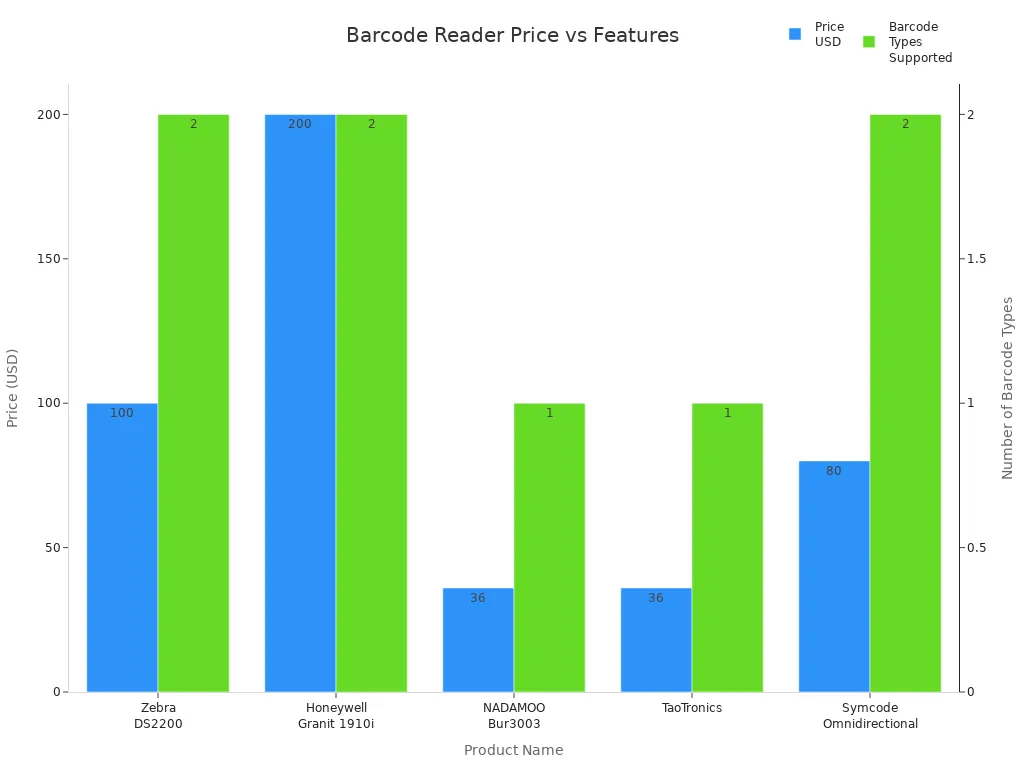
Managers should balance price with what features they need. Buying a good barcode reader can help teams work faster and make fewer mistakes.
Benefits for Logistics
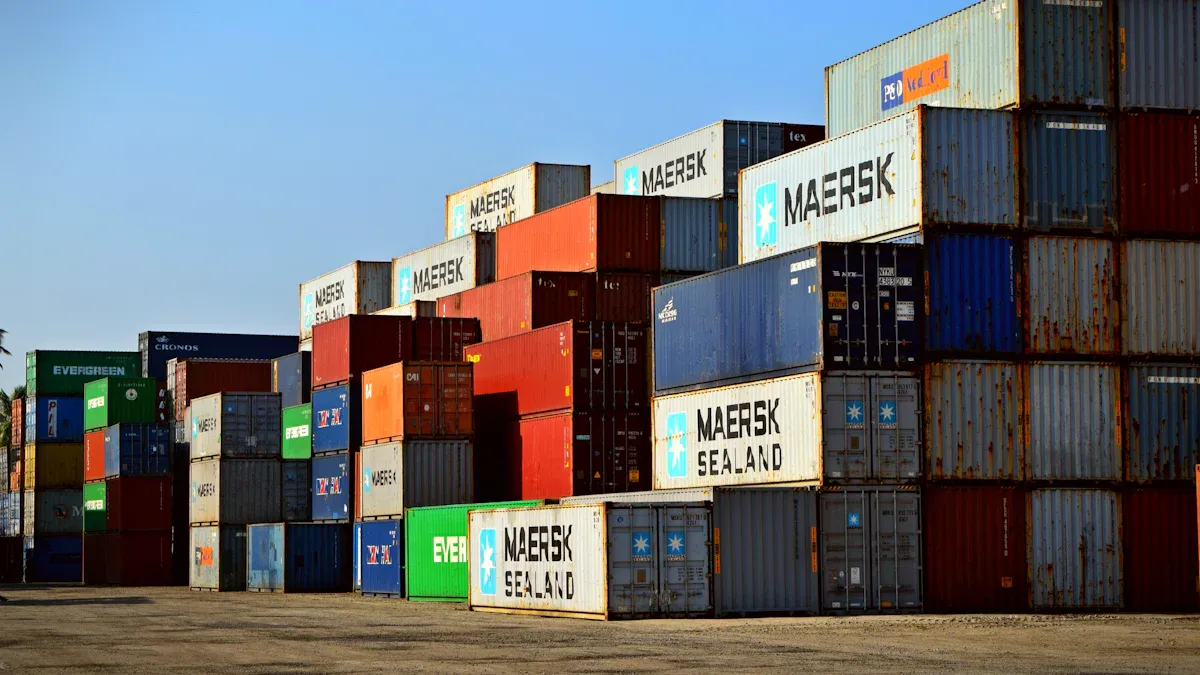
Efficiency
Modern barcode readers help logistics teams work faster. Workers can scan many barcodes at the same time. This cuts scanning time by half. Teams can handle more packages every hour. Companies like UPS now move more boxes after using better barcode systems. Wearable and wireless scanners let workers walk around easily. They do not waste steps and can use both hands for work. These scanners send info right to warehouse systems. This means updates happen right away. Teams see fewer slow spots and work goes smoother.
Faster package handling for shipping and receiving
Stock levels update right away for better control
Less manual work saves money
New scanning tools, like QR codes and computer vision, scan many items from any side. This keeps things moving and stops delays.
Accuracy
Barcode readers help teams make fewer mistakes. New 2D scanners read codes from any angle and get more details. One big online store lowered mistakes from 2.3% to 0.4% with 2D scanners. Car and medicine companies also have fewer errors and better inventory by using hybrid and 2D scanners. These gains come from automatic data capture. This means workers do not type in info by hand, so there are fewer mistakes.
Fewer mistakes when picking and packing
More details help track products better
Less wrong deliveries and returns
New tools like augmented reality scanning and machine learning help find and scan damaged barcodes. This makes the process even more dependable.
Workflow Optimization
Wearable and wireless barcode readers change how teams do their jobs. Light scanners help workers feel less tired during long shifts. Hands-free scanners, like ring or glove types, let workers hold things while scanning. This saves time on each job. Wireless scanners give instructions and alerts right to workers. This helps them learn faster and make fewer mistakes.
Hands-free scanning is faster and more comfy
Works well with warehouse management systems
Tough designs last in hard places
In the future, IoT, AI analytics, and smart packaging will help even more. These will make tracking faster and inventory smarter for logistics.
Logistics teams can work faster if they pick the right barcode reader. The best 10 choices scan well, last long, and connect to systems easily. The table below shows how wired and wireless scanners are different:
Feature | Wired Barcode Scanners | Wireless Barcode Scanners |
|---|---|---|
Cost | Cheaper to buy | Costs more at first |
Mobility | Can’t move far from cable | Easy to move around |
Maintenance | Needs little care | Needs battery checks |
To pick the best scanner, teams should:
Try scanners in real warehouse jobs.
Make sure lighting and barcode types fit daily work.
Ask workers for feedback and check if results help the business.
Teams that match device features to their work get more value and make fewer mistakes.
FAQ
What is the difference between 1D and 2D barcode readers?
1D barcode readers scan barcodes with lines. 2D barcode readers scan codes shaped like squares or rectangles. 2D readers can read both 1D and 2D codes. They also work faster than 1D readers. Most logistics teams use 2D readers for this reason.
How long does a typical barcode reader battery last?
Most barcode readers work for 8 to 18 hours per charge. Some have batteries you can swap quickly. This lets workers keep using them without stopping. Battery life depends on how much you use the device.
Can barcode readers work in cold or wet environments?
Many rugged barcode readers have high IP ratings. These devices keep out dust and water. They also work in very hot or cold places. Teams can use them in freezers or outside without problems.
Are wireless barcode readers secure for warehouse data?
Wireless barcode readers use Bluetooth or Wi-Fi to connect. Top brands add extra security to protect data. This keeps warehouse information safe while scanning and sending it.
How do teams choose the right barcode reader for their needs?
Step | Action |
|---|---|
1 | Look at warehouse conditions |
2 | Write down barcode types used |
3 | Test if devices work together |
4 | Compare features and prices |
Teams should pick barcode readers that fit their daily jobs. This helps them get the best results.

